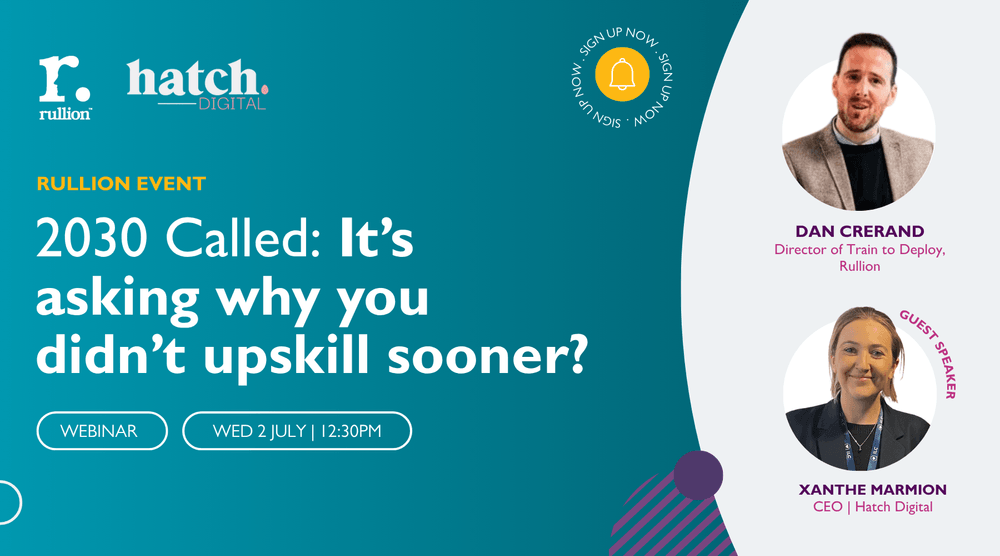5 Signs Your Workforce Needs a Train to Deploy Strategy
You need a Train to Deploy Strategy when you find yourself:
Rehiring the same roles repeatedly
Staring down a retirement cliff
Watching time-to-hire stall delivery
Falling behind on diversity and social value
Working with out of sync training providers
Train to Deploy, often referred to as a Hire Train Deploy or a Recruit Train Deploy model, is a workforce transformation solution where a provider designs, delivers, and deploys role-specific training up front, helping you plug skills gaps, onboard faster, and build work-ready teams from day one. This is typically done by bringing in transferable talent from adjacent sectors, reskilling deployed contractors, or hiring and training new external candidates aligned with your business goals.
Most organisations don’t always realise when they’re ready for a Train to Deploy (TTD) strategy. The signs build gradually. Recruitment pressures intensify quietly. Talent pools shrink. Skills gaps start to feel permanent. And the tools that once worked – your job boards, agencies, and graduate deployment schemes – no longer deliver the talent or speed you need.
If any of this feels familiar, you're not without options. A Train to Deploy strategy can help you rebuild confidence in your workforce plan, expand your reach, and reduce the hidden costs of reactive hiring. It’s one of the most effective ways to evolve your talent pipeline strategy to build scalable, work-ready teams.
Here are five signs that now might be the right time to make the shift.
1. You’re Rehiring the Same Roles Repeatedly
When roles start to become revolving doors, it’s often a sign that the problem isn’t just recruitment; it’s readiness. High turnover in key positions can point to poor role fit, lack of structured development, or unclear progression pathways. It burns through recruitment budgets, disrupts project continuity, and stalls long-term growth.
TTD flips the traditional model on its head. Instead of waiting for the “right” person to appear, you develop the capabilities you need within the people you hire or redeploy from day one. Rullion’s match-to-train approach directly addresses the root cause by designing role-specific training and onboarding ahead of deployment, ensuring the people coming into your organisation are better equipped, aligned, and more likely to stay. You’re building the talent you need, sustainably.
2. You’re Staring Down a Retirement Cliff
In critical infrastructure sectors, retirements are accelerating. In the UK energy and utilities sectors alone, 37% of the workforce will retire by 2030 – that’s around 168,400 vacancies that will need to be filled. And with them, decades of knowledge are walking out the door.
Our train and deploy solution bridges that gap before it opens. We help you upskill successors, build structured handovers, and onboard people who can shadow, learn, and grow into critical roles. We make sure that expertise isn’t lost. It’s transferred, evolved, and retained.
3. You’re Watching Time-to-Hire Stall Delivery
Every week you wait for a hire to land is a week your teams aren’t delivering. In project-based environments, those delays cascade into missed milestones, overstretched teams, and lost momentum.
A Hire Train Deploy strategy eliminates that lag. With custom training and onboarding ahead of deployment, candidates arrive equipped with the technical and behavioural readiness to contribute from day one. That upfront investment in preparation pays dividends in retention, and not just in performance. When new hires feel supported, skilled, and set up to succeed, they’re far more likely to stay.
4. You’re Falling Behind on Your Diversity and Social Value Goals
Most organisations have diversity targets and social value commitments, but traditional hiring often reaches the same narrow pools in the same ways.
Rullion’s Train to Deploy solution is built around inclusion without limits. If someone shows the right mindset, behaviours, and potential, we build the skillset, regardless of their background or circumstance. We don’t tick boxes or run generic ED&I programmes. We focus on opening doors to those with potential and create genuinely inclusive talent pipelines that reflect the communities you serve.
5. Your Training Providers Feel Out of Sync
As your organisation adapts to new technologies, delivery models, and regulatory changes, you need learning partners that can evolve just as fast. But many traditional training providers are slow to respond. Courses feel outdated, generic, or disconnected from the realities your teams face day-to-day. This disconnect leads to wasted investment, delayed impact, and talent that still isn’t ready for the job.
If your current provision feels out of sync, Rullion’s Train to Deploy strategy gives you control. You co-design the training journey to reflect your systems, tools, and standards, and we manage delivery, acting as the conduit between you and the training providers. We help embed learning into your operating model, whether through bespoke external programmes or scaling your own internal training. Making sure your people are learning what matters and applying it from day one.
Recognising the Signs
Every workforce challenge is an opportunity to rethink the way things have always been done. If any of these signs sound familiar, it may be time to reassess your approach. A Train to Deploy strategy offers a more proactive path, helping you build the skills, teams, and resilience you need to grow. Shift from reactive hiring to long-term capability building. And get ahead of change before talent gaps hold you back.
Helping you get work done
Visit our Train to Deploy solution page to see how a Train to Deploy strategy could work for your organisation or book a discovery call with one of our consultants.






